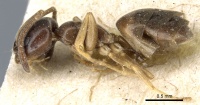Tapinoma sinense
| Tapinoma sinense | |
|---|---|

| |
| Scientific classification | |
| Kingdom: | Animalia |
| Phylum: | Arthropoda |
| Class: | Insecta |
| Order: | Hymenoptera |
| Family: | Formicidae |
| Subfamily: | Dolichoderinae |
| Genus: | Tapinoma |
| Species: | T. sinense |
| Binomial name | |
| Tapinoma sinense Emery, 1925 | |
| Synonyms | |
| |
Sexuals were found in the Tian Shan 29 July 1922 (Seifert et al., 2024).
Identification
Seifert et al. (2024) - Worker (Tab. 7, Figs. 12, 13): All shape ratios given below are primary ratios without RAv and all data are given as arithmetic mean ± standard deviation (n-weighted). Rather small, CS 673 ± 40 µm. Head very short, CL/CW 1.057 ± 0.035. Postocular distance large, PoOc/CL 0.444 ± 0.006. Anteromedian clypeal excision very shallow and very broad, ExCly/CS 2.76 ± 0.45 %, ExClyW 10.16 ± 1.52 %. Few pubescence hairs and small setae protruding a few micron across margin of clypeal excision, nExCly 2.33 ± 0.47. Posterior margin of head very slightly excavated, ExOcc/CS 0.74 ± 0.20 %. Scape very short, SL/CS 0.903 ± 0.012. Second funiculus segment short, Fu2L/CS 11.12 ± 0.04 %, IFu2 1.225 ± 0.091. Minimum distance of the inner margins of antennal socket rings moderate, dAN/CS 0.314 ± 0.010. Eye medium-sized, EL/CS 0.285 ± 0.011. Mesosoma moderately wide and short, MW/CS 0.650 ± 0.033, ML/CS 1.191 ± 0.015. Metanotal depression rather shallow, MGr/CS 2.94 ± 0.82 %. Color of head, mesosoma and gaster dirty brown, mandibles femora, tibiae, metatarsae and tarsae paler.
As a combination of very shallow clypeal excision, small CL/CW, small SL/CS, small ML/CS and large PoOc/CL, the species is not to confuse with any known species from Central and East Asia (Tab. 7).
Keys including this Species
Distribution
Latitudinal Distribution Pattern
Latitudinal Range: 42.70583333° to 41.508577°.
| North Temperate |
North Subtropical |
Tropical | South Subtropical |
South Temperate |
- Source: AntMaps, Seifert et al. (2024)
Distribution based on Regional Taxon Lists
Palaearctic Region: China (type locality), Democratic Peoples Republic of Korea, Kazakhstan (type locality), Kyrgyzstan, Mongolia, Republic of Korea, Russian Federation.
Distribution based on AntMaps
Distribution based on AntWeb specimens
Check data from AntWeb
Countries Occupied
| Number of countries occupied by this species based on AntWiki Regional Taxon Lists. In general, fewer countries occupied indicates a narrower range, while more countries indicates a more widespread species. |

|
Estimated Abundance
| Relative abundance based on number of AntMaps records per species (this species within the purple bar). Fewer records (to the left) indicates a less abundant/encountered species while more records (to the right) indicates more abundant/encountered species. |

|
Biology
Castes
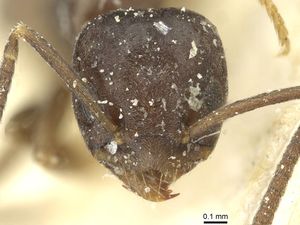 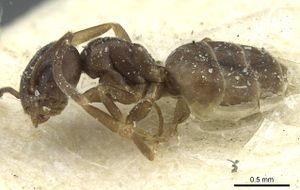 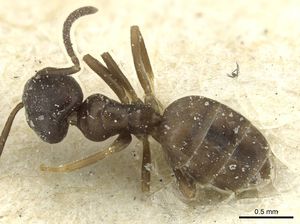 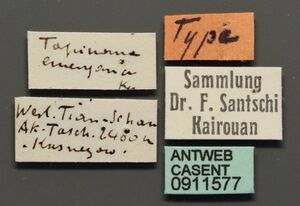
| |
| Syntype of Tapinoma emeryanum. Worker. Specimen code casent0911577. Photographer Z. Lieberman, uploaded by California Academy of Sciences. | Owned by Natural History Museum, Basel. |
Nomenclature
The following information is derived from Barry Bolton's Online Catalogue of the Ants of the World.
- sinense. Tapinoma sinense Emery, 1925d: 61, fig. 14 (w.) CHINA.
- Santschi, 1925f: 94 (q.m.).
- Status as species: Collingwood, 1976: 299.
- emeryanum. Tapinoma emeryanum Kuznetsov-Ugamsky, 1927d: 35 (w.q.m.) KAZAKHSTAN.
- Subspecies of sinense: Dlussky, 1962: 180.
- Status as species: Tarbinsky, 1976: 119.
- Junior synonym of sinense: Seifert et al., 2024: 64.
Type Material
Tapinoma sinense Emery, 1925 [evaluation of image of type]
Seifert et al. (2024) - The species has been described based on material collected by Zichy in Mongolia. The diagnosis is based on evaluation of the image CASENT0904016 in ww.antweb.org of a type worker labelled “”T. sinense Emery”, “Mongolia Burgaltai”, “Exp. Zichy leg. Csiki”, “IX.5.1898.”, “TYPUS”, “ANTWEB CASENT0904016”.
Tapinoma emeryanum Kuznetzov-Ugamsky, 1927 [evaluation of images of types]
Seifert et al. (2024) - This taxon has been described from two localities in the W Tian Shan region. Investigated were the images of a type worker (CASENT0911577 in www.antweb.org) labelled “West. Tian-Shan Ak-Tasch. 2400 m. Kuznezow”, “Tapinoma emeryana Ku”, “Type”, “Sammlung Dr. F. Santschi Kairouan”, “ANTWEB CASENT0911577” and images of a syntype worker (CASENT0917850 in www.antweb.org) labelled “..Tamerlanovka ..Bugunja...26/ VI -23”, “Syntypus Tapinoma emeryanum Kuzn.”, “N 460 3-0-0” and “ANTWEB CASENT0917850”.
Scatterplots of CL, CW, PoOc, SL, ML and dAN indicate synonymy of Tapinoma emeryanum with T. sinense and a wide distance from other species with shallow clypeal excision.
Description
References
- Collingwood, C. A. 1976a. Ants (Hymenoptera: Formicidae) from North Korea. Ann. Hist.-Nat. Mus. Natl. Hung. 68: 295-309 (page 299, see also)
- Dubovikoff, D.A., Yusupov, Z.M. 2017. Family Formicidae - Ants. In Belokobylskij S. A. and A. S. Lelej: Annotated catalogue of the Hymenoptera of Russia. Proceedingss of the Zoological Institute of the Russian Academy of Sciences 6: 197-210.
- Emery, C. 1925d. Hymenoptera. Fam. Formicidae. Subfam. Formicinae. Genera Insectorum 183: 1-302 (page 61, fig. 14 worker described)
- Santschi, F. 1925f. Contribution à la faune myrmécologique de la Chine. Bull. Soc. Vaudoise Sci. Nat. 56: 81-96 (page 94, queen, male described)
- Seifert, B., Kaufmann, B., Fraysse, L. 2024. A taxonomic revision of the Palaearctic species of the ant genus Tapinoma Mayr 1861 (Hymenoptera: Formicidae). Zootaxa 5435(1), 1-74 (doi:10.11646/zootaxa.5435.1.1).
References based on Global Ant Biodiversity Informatics
- Borowiec L. 2014. Catalogue of ants of Europe, the Mediterranean Basin and adjacent regions (Hymenoptera: Formicidae). Genus (Wroclaw) 25(1-2): 1-340.
- Choi B.M., Kim, C.H., Bang, J.R. 1993. Studies on the distribution of ants (Formicidae) in Korea (13). A checklist of ants from each province (Do), with taxonomic notes. Cheongju Sabom Taehakkyo Nonmunjip (Journal of Cheongju National University of Education) 30: 331-380.
- Collingwood C. A. 1976. Ants (Hymenoptera: Formicidae) from North Korea. Annales Historico-Naturales Musei Nationalis Hungarici 68:
- Collingwood C. A. 1981. Ants (Hymenoptera: Formicidae) from Korea, 2. Folia Entomologica Hungarica 42(34): 25-30.
- Dubovikoff D. A., and Z. M. Yusupov. 2018. Family Formicidae - Ants. In Belokobylskij S. A. and A. S. Lelej: Annotated catalogue of the Hymenoptera of Russia. Proceedingss of the Zoological Institute of the Russian Academy of Sciences 6: 197-210.
- Guénard B., and R. R. Dunn. 2012. A checklist of the ants of China. Zootaxa 3558: 1-77.
- Hua Li-zhong. 2006. List of Chinese insects Vol. IV. Pages 262-273. Sun Yat-sen university Press, Guangzhou. 539 pages.
- Kim B.J. 1996. Synonymic list and distribution of Formicidae (Hymenoptera) in Korea. Entomological Research Bulletin Supplement 169-196.
- Kim B.J., and K.G. Kim. 1999. Systematic study of Dolichoderinae (Hymenoptera: Formicidae) in Korea. Korean Journal of Entomology 29(1): 17-22.
- Marikovsky P. I. 1979. Ants of the Semireche Desert. [In Russian.]. Alma Ata: Nauka, 263 pp.
- Paik W.H. 1984. A checklist of Formicidae (Hymenoptera) of Korea. Korean J. Plant Prot. 23(3): 193-195.
- Radchenko, A. 2005. Monographic revision of the ants (Hymenoptera: Formicidae) of North Korea. Annales Zoologici (Warsaw) 55: 127-221.
- Radchenko, A. 2005. Monographic revision of the ants (Hymenoptera, Formicidae) of North Korea. Annales Zoologici 55(2): 127-221.
- Santschi F. 1925. Contribution à la faune myrmécologique de la Chine. Bulletin de la Société Vaudoise des Sciences Naturelles 56: 81-96.
- Terayama M., Choi, B.M., Kim, C.H. 1992. A check list of ants from Korea, with taxonomic notes. Bulletin of the Toho Gakuen 7:19-54.
